外研版(2019)选择性必修 第一册Unit 4 Meeting the muse Using language公开课课件(共35张PPT)
文档属性
| 名称 | 外研版(2019)选择性必修 第一册Unit 4 Meeting the muse Using language公开课课件(共35张PPT) | 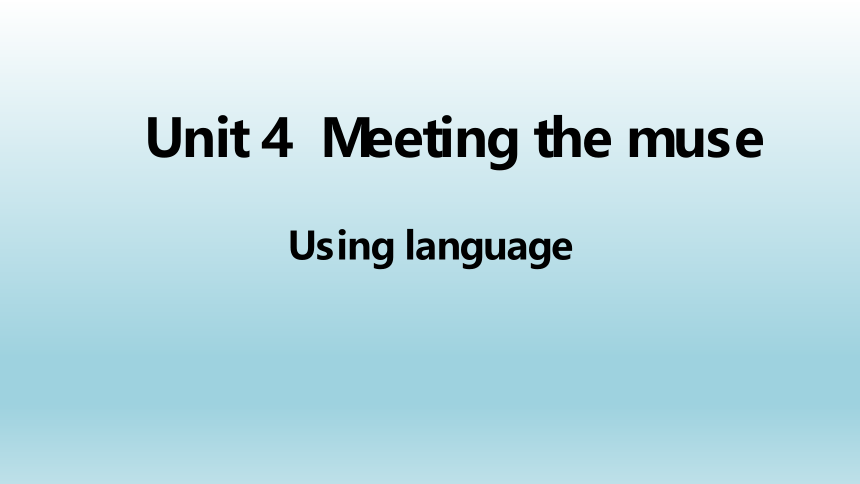 | |
| 格式 | pptx | ||
| 文件大小 | 764.0KB | ||
| 资源类型 | 教案 | ||
| 版本资源 | 外研版(2019) | ||
| 科目 | 英语 | ||
| 更新时间 | 2023-03-02 17:00:54 | ||
图片预览

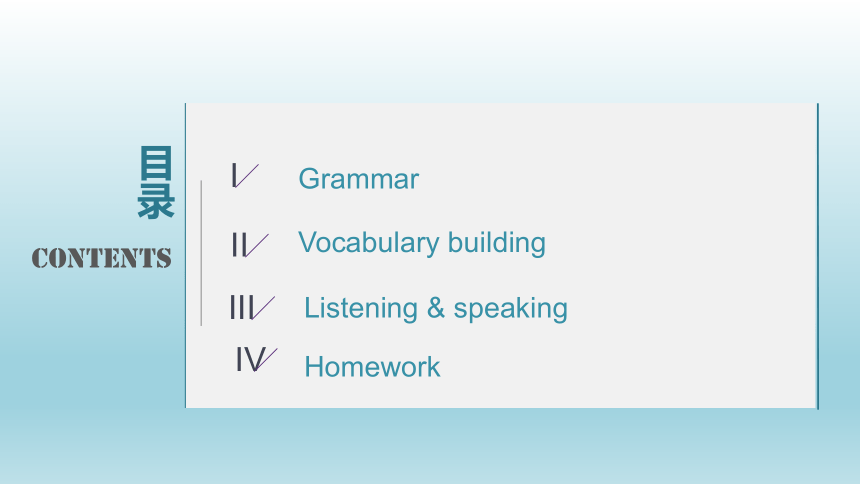
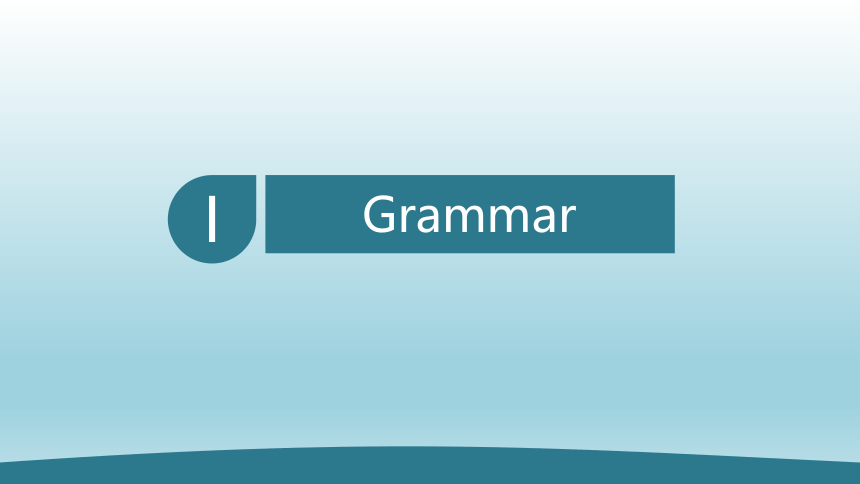
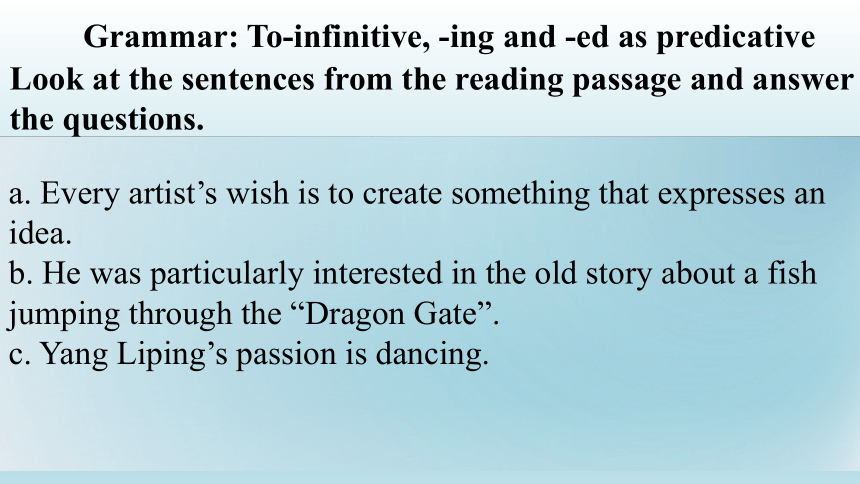
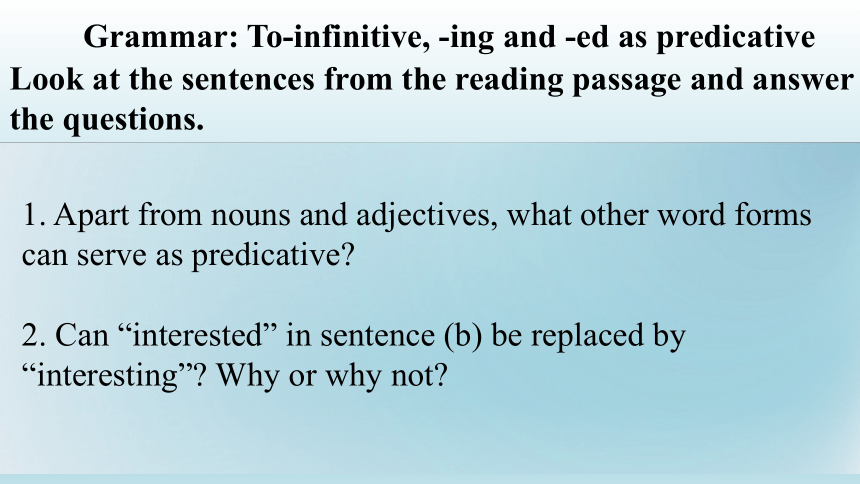
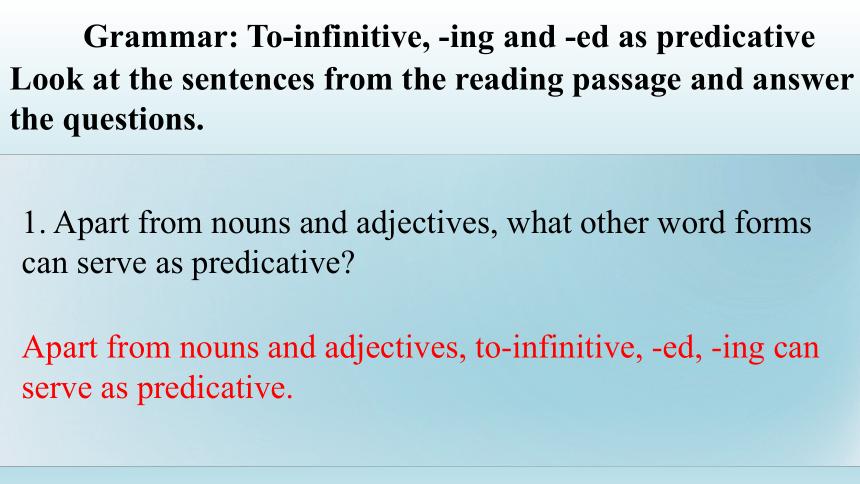
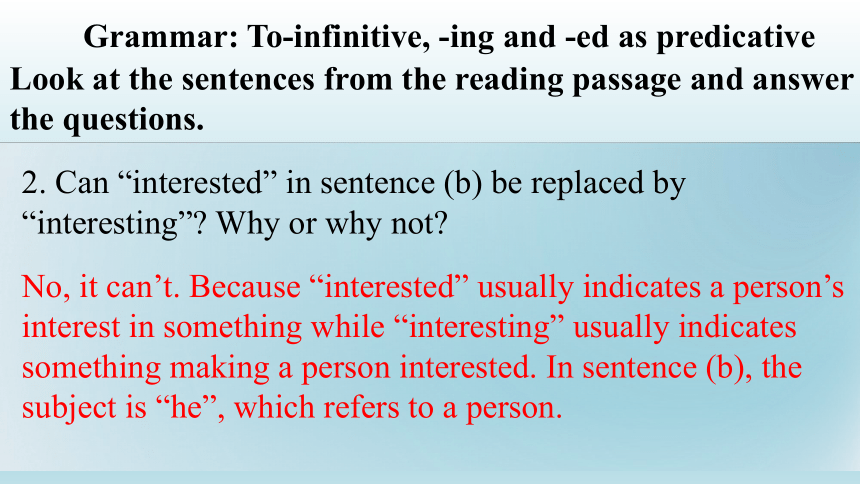
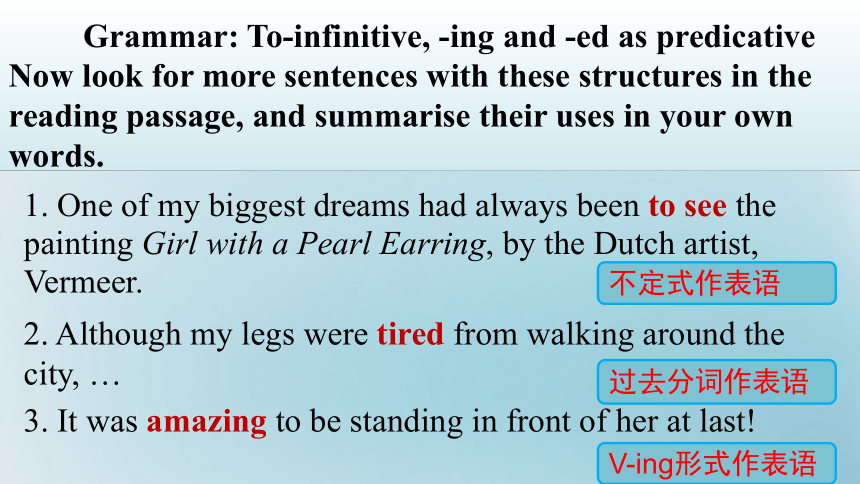

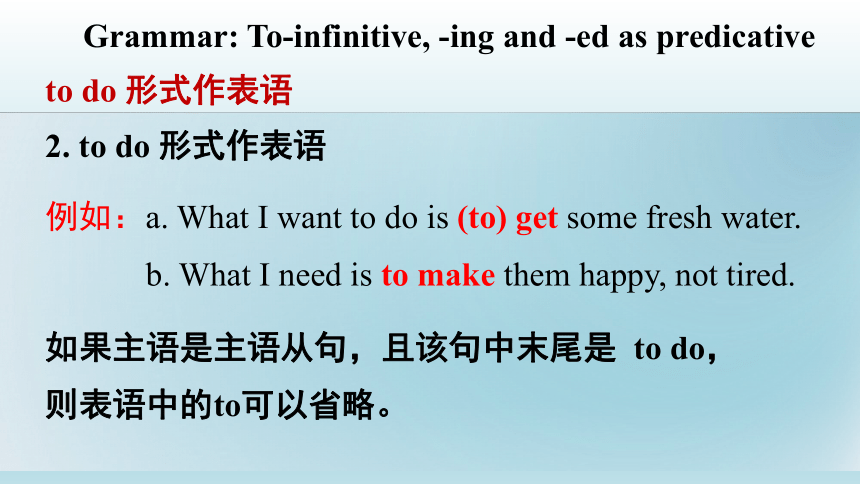
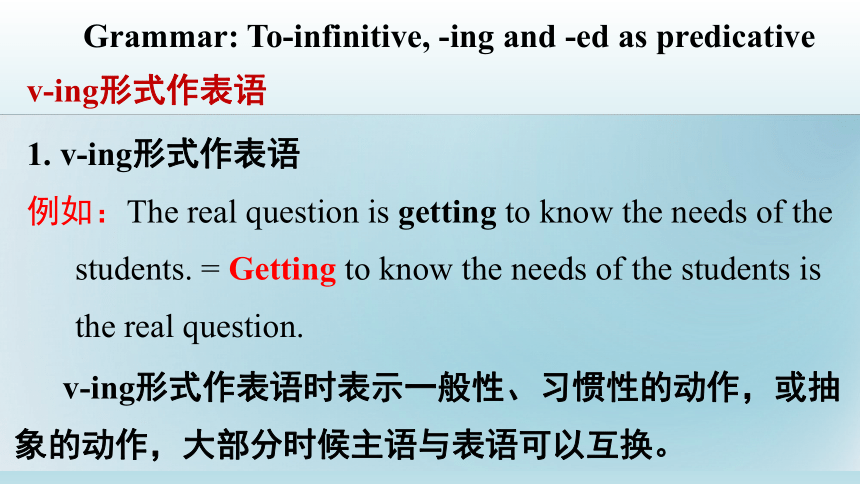

文档简介
(共35张PPT)
Using language
Unit 4 Meeting the muse
目录
contents
Grammar
I
IV
Vocabulary building
II
Listening & speaking
III
Homework
I
Grammar
a. Every artist’s wish is to create something that expresses an idea.
b. He was particularly interested in the old story about a fish jumping through the “Dragon Gate”.
c. Yang Liping’s passion is dancing.
Grammar: To-infinitive, -ing and -ed as predicative
Look at the sentences from the reading passage and answer the questions.
Grammar: To-infinitive, -ing and -ed as predicative
1. Apart from nouns and adjectives, what other word forms can serve as predicative
2. Can “interested” in sentence (b) be replaced by “interesting” Why or why not
Look at the sentences from the reading passage and answer the questions.
Grammar: To-infinitive, -ing and -ed as predicative
1. Apart from nouns and adjectives, what other word forms can serve as predicative
Apart from nouns and adjectives, to-infinitive, -ed, -ing can serve as predicative.
Look at the sentences from the reading passage and answer the questions.
Grammar: To-infinitive, -ing and -ed as predicative
2. Can “interested” in sentence (b) be replaced by “interesting” Why or why not
No, it can’t. Because “interested” usually indicates a person’s interest in something while “interesting” usually indicates something making a person interested. In sentence (b), the subject is “he”, which refers to a person.
Look at the sentences from the reading passage and answer the questions.
2. Although my legs were tired from walking around the city, …
Now look for more sentences with these structures in the
reading passage, and summarise their uses in your own
words.
Grammar: To-infinitive, -ing and -ed as predicative
1. One of my biggest dreams had always been to see the painting Girl with a Pearl Earring, by the Dutch artist, Vermeer.
V-ing形式作表语
不定式作表语
过去分词作表语
3. It was amazing to be standing in front of her at last!
例如:My purpose is to climb to the top of the snow
mountain.(我的目标就是要爬到雪山的顶部。)
to do 形式作表语
Grammar: To-infinitive, -ing and -ed as predicative
1. to do 形式作表语
动词不定式形式作表语时表示的动作往往是具体的、一次性的动作,特别是将来的动作。通常主语是表示“目的,愿望,梦想,需求”等的名词或what引导的主语从句。
例如:a. What I want to do is (to) get some fresh water.
b. What I need is to make them happy, not tired.
to do 形式作表语
Grammar: To-infinitive, -ing and -ed as predicative
2. to do 形式作表语
如果主语是主语从句,且该句中末尾是 to do,则表语中的to可以省略。
1. v-ing形式作表语
例如:The real question is getting to know the needs of the students. = Getting to know the needs of the students is the real question.
v-ing形式作表语
Grammar: To-infinitive, -ing and -ed as predicative
v-ing形式作表语时表示一般性、习惯性的动作,或抽象的动作,大部分时候主语与表语可以互换。
2. v-ing形式作表语
例如:The news is really exciting.
v-ing形式作表语
Grammar: To-infinitive, -ing and -ed as predicative
v-ing形式作表语还可以表示主语具有的特征和属性。
例如:a. The cups were broken by the waitress.
杯子被服务员打碎了。(broken表示被动关系)
b. The cups are broken.
杯子碎了。(broken表示主语的存在状态)
c. I am very disappointed at the news.
我对这个消息感到很失望。(disappointed表示主语的情绪——感到失望)
v-ed形式作表语
Grammar: To-infinitive, -ing and -ed as predicative
v-ed形式作表语时表示主语(人和事物)的被动关系或存在状态或情感情绪等。
Complete the passage with the correct form of the verbs in brackets.
Chinese artist Wu Guanzhong is 1 ______ (know) for his paintings using oils and also for those using the more traditional Chinese method of ink. According to Wu Guanzhong, his goal as an artist was 2 _________ (combine) Western principles of art with Chinese spirit, and his passion is 3 _______ (seek)a point at which the two could meet. To him, the important value of an artwork was 4 ________(reflect) the art within the life of Chinese people,
known
to combine
to seek
to reflect
Complete the passage with the correct form of the verbs in brackets.
and 5 __________ (express)love of and responsibility to his motherland. Wu Guanzhong remained 6 _________ (interest) in exploring ways of expression, with his style changing and developing throughout his career. His life's work is now 7 ________ (inspire) artists not only in China but across the world.
to express
interested
inspiring
II
Vocabulary building
Vocabulary building: Compound adjectives
Read the comments and answer the questions. Pay attention to the compound adjectives in bold.
1. What is the exhibition about What artworks might you see in it
2. Which comment makes the greatest impression on you Give your reasons.
3. Do you want to go to this exhibition after reading the comments Why or why not
Vocabulary building: Compound adjectives
The exhibition is about abstract art. We can see Storm and Superhighway in it.
1. What is the exhibition about What artworks might you see in it
Read the comments and answer the questions. Pay attention to the compound adjectives in bold.
Vocabulary building: Compound adjectives
2. Which comment makes the greatest impression on you Give your reasons.
3. Do you want to go to this exhibition after reading the comments Why or why not
Various answers are possible.
Show your own answers to Exercise 2 & 3.
Read the comments and answer the questions. Pay attention to the compound adjectives in bold.
In English, you can create compound adjectives by joining two or more words together. You can guess the meaning of compound adjectives by looking at the individual words that make them up. You can even try creating your own compound adjectives!
Guidance for your compound adjectives
Vocabulary building: Compound adjectives
Match the compound adjectives in the above to their meanings. Think of other words and expressions that can express the same meanings.
Vocabulary building: Compound adjectives
1. _____________: extremely impressive so as to take one’s breath away
2. ____________: known by a lot of people
3._____________: making you feel great respect and admiration, and sometimes fear
breathtaking
well-known
awe-inspiring
Vocabulary building: Compound adjectives
4. _____________: very good at doing something
5. ___________________: innovative, using new methods or achieving new results
6. ___________: very expensive
highly-skilled
ground-breaking
over-priced
Match the compound adjectives in the above to their meanings. Think of other words and expressions that can express the same meanings.
Work in groups and
think of more compound adjectives to describe
an art exhibition or an artwork.
Vocabulary building: Compound adjectives
III
Listening & speaking
Listening & speaking: Before listening
1. What else do you know about Pablo Picasso and Feng Zikai
2. What other artists are famous for representing war and peace What are their best-known artworks
Did You Know
Read the passage and answer the questions.
Listening & speaking: While-listening
Listen to the audio guide and find out the main message of each artwork.
Listening & speaking: While-listening
Listen again and complete the notes.
Guernica, by Pablo Picasso
Painted after 1 __________________ of Guernica
Size: 2 ________________________________________
Images: a bull, a horse, a light bulb and a(n) 3 __________________ lying on the ground
Using only three colours for 4 ___________________
the attack on the town
3.5 metres in height and almost 8 metres in width
dead or wounded man
a more powerful effect
Listening & speaking: While-listening
The Battlefield in Spring, by Feng Zikai
Painted 5 __________ Japanese aggression against China
Images: sandbags, an army cap, a wire fence and 6 _______________
Contrast achieved with 7 ______________________
______________________
Showing Feng Zikai’ 8 _____________________________
_____________________________
in protest of
some grass leaves
the lifeless objects and the
grass leaves
encouragement to the Chinese people as well as his hope for peace
Listen again and complete the notes.
Listening & speaking: Post-listening
Now work in pairs. Discuss which artwork makes the greater impression on you and why. Listen again if necessary.
Discussion:
Listening & speaking: Post-listening
Complete the table with the expressions from the audio guide.
… by the well-known …
It measures …
In the centre of the painting, we can see …
Through … , I can see / feel …
In my opinion, this makes …
… create a strong contrast.
I personally think …
It is widely believed …
Listening & speaking: Post-listening
About an artwork Basic information What you see How you feel
… by the well-known …
It measures …
It is widely believed …
In the centre of the painting, we can see …
Through … , I can see / feel …
Through … , I can feel …
In my opinion, this makes …
… create a strong contrast.
I personally think…
Complete the table with the expressions from the audio guide.
Listening & speaking: Post-listening
Choose an art exhibition, or an artwork from an exhibition you like, and write about it using the words and expressions in this section.
Listening & speaking: Pair work
Work in pairs. Make improvements to each other’s writings and share them with the class.
IV
Homework
Homework
1. Think of more compound adjectives to describe an art exhibition or an artwork.
2. Use the expressions learnt in this section to modify your writing.
Using language
Unit 4 Meeting the muse
目录
contents
Grammar
I
IV
Vocabulary building
II
Listening & speaking
III
Homework
I
Grammar
a. Every artist’s wish is to create something that expresses an idea.
b. He was particularly interested in the old story about a fish jumping through the “Dragon Gate”.
c. Yang Liping’s passion is dancing.
Grammar: To-infinitive, -ing and -ed as predicative
Look at the sentences from the reading passage and answer the questions.
Grammar: To-infinitive, -ing and -ed as predicative
1. Apart from nouns and adjectives, what other word forms can serve as predicative
2. Can “interested” in sentence (b) be replaced by “interesting” Why or why not
Look at the sentences from the reading passage and answer the questions.
Grammar: To-infinitive, -ing and -ed as predicative
1. Apart from nouns and adjectives, what other word forms can serve as predicative
Apart from nouns and adjectives, to-infinitive, -ed, -ing can serve as predicative.
Look at the sentences from the reading passage and answer the questions.
Grammar: To-infinitive, -ing and -ed as predicative
2. Can “interested” in sentence (b) be replaced by “interesting” Why or why not
No, it can’t. Because “interested” usually indicates a person’s interest in something while “interesting” usually indicates something making a person interested. In sentence (b), the subject is “he”, which refers to a person.
Look at the sentences from the reading passage and answer the questions.
2. Although my legs were tired from walking around the city, …
Now look for more sentences with these structures in the
reading passage, and summarise their uses in your own
words.
Grammar: To-infinitive, -ing and -ed as predicative
1. One of my biggest dreams had always been to see the painting Girl with a Pearl Earring, by the Dutch artist, Vermeer.
V-ing形式作表语
不定式作表语
过去分词作表语
3. It was amazing to be standing in front of her at last!
例如:My purpose is to climb to the top of the snow
mountain.(我的目标就是要爬到雪山的顶部。)
to do 形式作表语
Grammar: To-infinitive, -ing and -ed as predicative
1. to do 形式作表语
动词不定式形式作表语时表示的动作往往是具体的、一次性的动作,特别是将来的动作。通常主语是表示“目的,愿望,梦想,需求”等的名词或what引导的主语从句。
例如:a. What I want to do is (to) get some fresh water.
b. What I need is to make them happy, not tired.
to do 形式作表语
Grammar: To-infinitive, -ing and -ed as predicative
2. to do 形式作表语
如果主语是主语从句,且该句中末尾是 to do,则表语中的to可以省略。
1. v-ing形式作表语
例如:The real question is getting to know the needs of the students. = Getting to know the needs of the students is the real question.
v-ing形式作表语
Grammar: To-infinitive, -ing and -ed as predicative
v-ing形式作表语时表示一般性、习惯性的动作,或抽象的动作,大部分时候主语与表语可以互换。
2. v-ing形式作表语
例如:The news is really exciting.
v-ing形式作表语
Grammar: To-infinitive, -ing and -ed as predicative
v-ing形式作表语还可以表示主语具有的特征和属性。
例如:a. The cups were broken by the waitress.
杯子被服务员打碎了。(broken表示被动关系)
b. The cups are broken.
杯子碎了。(broken表示主语的存在状态)
c. I am very disappointed at the news.
我对这个消息感到很失望。(disappointed表示主语的情绪——感到失望)
v-ed形式作表语
Grammar: To-infinitive, -ing and -ed as predicative
v-ed形式作表语时表示主语(人和事物)的被动关系或存在状态或情感情绪等。
Complete the passage with the correct form of the verbs in brackets.
Chinese artist Wu Guanzhong is 1 ______ (know) for his paintings using oils and also for those using the more traditional Chinese method of ink. According to Wu Guanzhong, his goal as an artist was 2 _________ (combine) Western principles of art with Chinese spirit, and his passion is 3 _______ (seek)a point at which the two could meet. To him, the important value of an artwork was 4 ________(reflect) the art within the life of Chinese people,
known
to combine
to seek
to reflect
Complete the passage with the correct form of the verbs in brackets.
and 5 __________ (express)love of and responsibility to his motherland. Wu Guanzhong remained 6 _________ (interest) in exploring ways of expression, with his style changing and developing throughout his career. His life's work is now 7 ________ (inspire) artists not only in China but across the world.
to express
interested
inspiring
II
Vocabulary building
Vocabulary building: Compound adjectives
Read the comments and answer the questions. Pay attention to the compound adjectives in bold.
1. What is the exhibition about What artworks might you see in it
2. Which comment makes the greatest impression on you Give your reasons.
3. Do you want to go to this exhibition after reading the comments Why or why not
Vocabulary building: Compound adjectives
The exhibition is about abstract art. We can see Storm and Superhighway in it.
1. What is the exhibition about What artworks might you see in it
Read the comments and answer the questions. Pay attention to the compound adjectives in bold.
Vocabulary building: Compound adjectives
2. Which comment makes the greatest impression on you Give your reasons.
3. Do you want to go to this exhibition after reading the comments Why or why not
Various answers are possible.
Show your own answers to Exercise 2 & 3.
Read the comments and answer the questions. Pay attention to the compound adjectives in bold.
In English, you can create compound adjectives by joining two or more words together. You can guess the meaning of compound adjectives by looking at the individual words that make them up. You can even try creating your own compound adjectives!
Guidance for your compound adjectives
Vocabulary building: Compound adjectives
Match the compound adjectives in the above to their meanings. Think of other words and expressions that can express the same meanings.
Vocabulary building: Compound adjectives
1. _____________: extremely impressive so as to take one’s breath away
2. ____________: known by a lot of people
3._____________: making you feel great respect and admiration, and sometimes fear
breathtaking
well-known
awe-inspiring
Vocabulary building: Compound adjectives
4. _____________: very good at doing something
5. ___________________: innovative, using new methods or achieving new results
6. ___________: very expensive
highly-skilled
ground-breaking
over-priced
Match the compound adjectives in the above to their meanings. Think of other words and expressions that can express the same meanings.
Work in groups and
think of more compound adjectives to describe
an art exhibition or an artwork.
Vocabulary building: Compound adjectives
III
Listening & speaking
Listening & speaking: Before listening
1. What else do you know about Pablo Picasso and Feng Zikai
2. What other artists are famous for representing war and peace What are their best-known artworks
Did You Know
Read the passage and answer the questions.
Listening & speaking: While-listening
Listen to the audio guide and find out the main message of each artwork.
Listening & speaking: While-listening
Listen again and complete the notes.
Guernica, by Pablo Picasso
Painted after 1 __________________ of Guernica
Size: 2 ________________________________________
Images: a bull, a horse, a light bulb and a(n) 3 __________________ lying on the ground
Using only three colours for 4 ___________________
the attack on the town
3.5 metres in height and almost 8 metres in width
dead or wounded man
a more powerful effect
Listening & speaking: While-listening
The Battlefield in Spring, by Feng Zikai
Painted 5 __________ Japanese aggression against China
Images: sandbags, an army cap, a wire fence and 6 _______________
Contrast achieved with 7 ______________________
______________________
Showing Feng Zikai’ 8 _____________________________
_____________________________
in protest of
some grass leaves
the lifeless objects and the
grass leaves
encouragement to the Chinese people as well as his hope for peace
Listen again and complete the notes.
Listening & speaking: Post-listening
Now work in pairs. Discuss which artwork makes the greater impression on you and why. Listen again if necessary.
Discussion:
Listening & speaking: Post-listening
Complete the table with the expressions from the audio guide.
… by the well-known …
It measures …
In the centre of the painting, we can see …
Through … , I can see / feel …
In my opinion, this makes …
… create a strong contrast.
I personally think …
It is widely believed …
Listening & speaking: Post-listening
About an artwork Basic information What you see How you feel
… by the well-known …
It measures …
It is widely believed …
In the centre of the painting, we can see …
Through … , I can see / feel …
Through … , I can feel …
In my opinion, this makes …
… create a strong contrast.
I personally think…
Complete the table with the expressions from the audio guide.
Listening & speaking: Post-listening
Choose an art exhibition, or an artwork from an exhibition you like, and write about it using the words and expressions in this section.
Listening & speaking: Pair work
Work in pairs. Make improvements to each other’s writings and share them with the class.
IV
Homework
Homework
1. Think of more compound adjectives to describe an art exhibition or an artwork.
2. Use the expressions learnt in this section to modify your writing.
